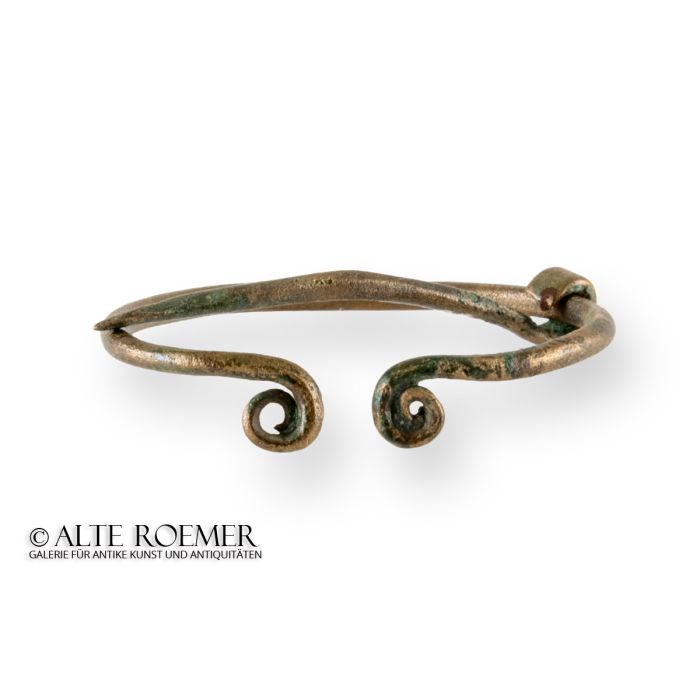Celtic penannular brooch
Price: on request
Sold
Object number
AR3360-02
| Object: |
Celtic penannular brooch
|
| Material: |
Bronze.
|
| Period: |
1st century AD. Celtic, at the time after the Roman invasion of Britain. |
| Description: |
The Celtic brooch made of bronze has the shape of an open ring with twisted ends. A needle runs on the ring, the end of which is flattened and bent into an eyelet. This type of fibula is called penannular brooch. It is also known as Omega fibula in German literature, after the characteristic shape of the clasp. Based on the find spot and style, Hattatt speculated that the Celtic Durotriges tribe was the creator of the brooch. He recorded the 1st century BC as the date of manufacture, but at the same time assigned the design to Fowler type C, which corresponds rather to the 1st century AD. By the later period, the Durotriges area had already been incorporated into Roman Britain. |
| Background: |
Fibulae were more than just brooches or pins for fastening garments. They were jewellery and status symbol and were worn prominently near the shoulder. This explains the abundance of fashionable shapes and styles that can be observed with surviving ancient pieces. They vary with region, era and social background of the wearer. Modern archaeology uses that distinctiveness to quickly attribute an archaeological find whenever a fibula is part of it.
|
| Dimensions: |
40mm x 30mm.
|
| Condition: |
Very good condition, including original pin. Surface cleaned by a previous owner. White inscription "2254" on the brooch. Includes original stand with inscription from the Hattatt collection.
|
| Provenance: |
Acquired by us on the British art market in 2021. Previously in the inventory of a British art dealer, acquired from the British collector Martin Schoyen. Mr. Schoyen purchased the fibula from the London antiquarian Bernard Quaritch. He bought it at the Christie's London auction on 7 July 1993, lot 72. Previously in the British private collection of Richard Hattatt. Acquired between 1970 and 1985. Hattatt reported a find spot near Norwich in Norfolk, Great Britain. About Richard Hattatt: After retiring from the family business, Richard Hattatt devoted himself to collecting and studying antiquities. After a few years, focusing on the area of fibulae, one of the most important collections of ancient brooches from the region north of the Mediterranean emerged. In the years 1982, 1985, 1987 and 1989, four books were the fruit of a tireless analysis and work on the specimen in his collection. Those books are now regarded as standard works in the field of Iron Age and Roman brooches. When Richard Hattatt died in 1992, parts of his collection were already housed in the Ashmolean Museum (Oxford) and the Wiltshire Museum (Devizes). Other fibulae in the collection went to auction houses and into private collections. However, the enormous gain in knowledge through the systematic collecting activity, the drawings and the information consolidated by Hattatt has been preserved for posterity in his books. It is with the appropriate pride that we can offer you this fibula from Hattatt's collection and his books. |
| Publications: |
This fibula is published in a standard work for ancient brooches, Richard Hattatt, Iron Age and Roman Brooches (1985), p. 186f, fig. 74, no. 650. Note that the numbering in Hattatt's publications differs from the collection numbers written on the fibulae. The fibula is also published in the reference catalogue Richard Hattatt, A Visual Catalogue of Richard Hattatt's Ancient Brooches (1989), p. 340, fig. 199, no. 650. |
| Literature: |
As an alternative to the works of Hattatt we can recommend the following book as an introduction and for referencing: R. Heynowski, Bestimmungsbuch Archäologie 1, Fibeln (2012). |
| Authenticity: |
We unconditionally guarantee the authenticity of every artefact, all items are subject to our lifetime return policy on authenticity.
|


